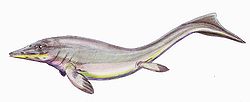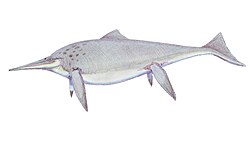| Catutosaurus Temporal range: | |
|---|---|
| Scientific classification | |
| Kingdom: | Animalia |
| Phylum: | Chordata |
| Class: | Reptilia |
| Superorder: | † Ichthyopterygia |
| Order: | † Ichthyosauria |
| Family: | † Ophthalmosauridae |
| Genus: | † Catutosaurus Fernández et al, 2021 |
| Type species | |
| Catutosaurus gaspariniae Fernández et al, 2021 | |
Catutosaurus is an ophthalmosaurid ichthyosaur from the Late Jurassic Vaca Muerta Formation of Argentina. It contains a single species, Catutosaurus gaspariniae. [1]
The generic name refers to the Los Catutos site. The specific name honours Zulma Gasparini.
The holotype is MOZ-PV-1854, a skull, lower jaws and front torso. Referred are specimina MOZ-PV-103, a skull with lower jaws, and MOZ-PV-7260, a set of snout fragments.







